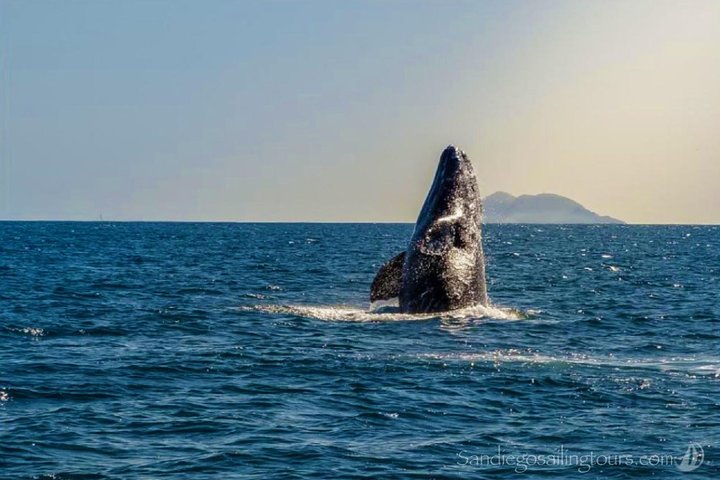Swell and Silence Off Coronado: A Half-Day Marine Wildlife Sail in San Diego
Sail beyond the Coronado Bridge for a half-day of whales, dolphins, and Pacific calm—lunch included.
The Pacific greets you with a cool breath as the marina wakes—halyards ticking like impatient metronomes, the Coronado Bridge stretching its blue arc toward a day that promises both calm and surprise. You step aboard, the deck firm beneath your shoes and the bay slipping past in a mosaic of reflections: city skyline to starboard, Navy gray hulks to port, pelicans winging low like they’ve already mapped the morning’s currents. San Diego Bay unspools behind you as the boat noses out, leaving the lee of land for the open light. The ocean blinks back, deceptively smooth, as if urging you to come closer.
Trail Wisdom
Layer Up Smart
Coastal mornings can be cool even in summer; bring a light windbreaker and a mid-layer you can shed as the sun warms.
Beat Seasickness Early
If you’re motion-sensitive, take medication or use bands 30–60 minutes before departure—prevention works better than cure.
Respect Marine Distance
Follow NOAA guidelines: observe whales at 100 yards or more and avoid crossing travel paths; let wildlife set the terms.
Protect from the Elements
Sunscreen, hat, and polarized sunglasses cut glare and prevent sunburn amplified by reflective water.
Local Knowledge
Hidden Gems
- •Cabrillo National Monument tidepools at low tide for close-up marine life
- •Living Coast Discovery Center in Chula Vista for kid-friendly coastal ecology
Wildlife
California sea lions, Common dolphins
Conservation Note
Parts of this coast are within marine protected areas; operators follow viewing distance guidelines to reduce stress on wildlife. Choose reef-safe sunscreen and pack out all trash.
San Diego Bay has been a maritime hub since Juan Rodríguez Cabrillo sailed into the harbor in 1542; today it remains both a Navy stronghold and a gateway to some of California’s richest nearshore ecosystems.
Seasonal Guide
spring
Best for: Migratory bird activity, Calm mornings
Challenges: Variable wind, Occasional marine layer
Spring brings changing winds and clear visibility between marine layers. Expect mixed seas with bright, mild days.
summer
Best for: Blue whale sightings, Warm temperatures
Challenges: Midday glare, Afternoon winds
Summer offers warm decks and potential blue whale encounters. Mornings are calmer; afternoons see stronger breezes.
fall
Best for: Stable weather, Golden light
Challenges: Santa Ana conditions, Patchy fog
Fall is reliably pleasant with great photography light. Watch forecasts for offshore winds and brief fog banks.
winter
Best for: Gray whale migration, Crisp visibility
Challenges: Cooler temps, Occasional swell
Winter delivers prime gray whale viewing and clear skies. Dress warmer and expect a livelier ocean on windy days.
Photographer's Notes
What to Bring
Light WindbreakerEssential
Keeps you warm against ocean breeze without bulk so you can move around the deck.
Polarized SunglassesEssential
Reduces glare on the water and improves your ability to spot wildlife at the surface.
Compact Binoculars (8x)
Enhances distant sightings and bird identification without being cumbersome.
Camera Strap or Wrist Lanyard
Prevents accidental drops when the boat rocks or a surprise moment pulls your attention.
Common Questions
Are wildlife sightings guaranteed?
No, the ocean is unpredictable, but San Diego’s rich waters offer frequent sightings of dolphins, sea lions, seabirds, and seasonal whales.
Will I get seasick?
Some guests do. Take motion-sickness remedies 30–60 minutes before departure and focus on the horizon once underway.
What should I wear?
Dress in layers with non-slip shoes; bring a hat, sunglasses, and sunscreen. Even warm days can feel cool on the water.
Is lunch included?
Yes, a simple onboard lunch is included on this tour. Notify the operator in advance of any dietary restrictions.
Is the tour family-friendly?
Yes. It’s suitable for most ages; always supervise children closely when moving around the deck.
Is the boat wheelchair accessible?
Accessibility varies by vessel. Contact the operator before booking to confirm ramp access and restroom dimensions.
What to Pack
Layered jacket for ocean breeze; polarized sunglasses to cut glare; compact binoculars to spot distant blows; non-slip shoes for safe footing on a moving deck.
Did You Know
Gray whales migrate up to 12,000 miles round-trip between Arctic feeding grounds and Baja California nurseries—one of the longest migrations of any mammal.
Quick Travel Tips
Arrive 20–30 minutes early for parking and check-in; morning departures are generally calmer; bring cash or a card for gratuities; notify the operator of dietary needs at booking.
Local Flavor
After docking, grab a fish taco at Mitch’s Seafood on Shelter Island or a crab sandwich at Point Loma Seafoods. If you’re ferrying to Coronado, pair a harbor walk with a pint at Coronado Brewing Company. For variety, Liberty Public Market in Point Loma packs local vendors under one roof—perfect for post-sail grazing.
Logistics Snapshot
Closest airport: SAN (San Diego International), 10–15 minutes to most marinas. Departures typically leave from the Embarcadero, Harbor Island, or Shelter Island. Expect strong cell service near shore. No permits needed for passengers; arrive early to find parking and check in.
Sustainability Note
This coastline borders marine protected areas and critical wildlife habitat. Keep voices low near animals, never feed wildlife, use reef-safe sunscreen, and follow crew instructions for responsible viewing distances.
